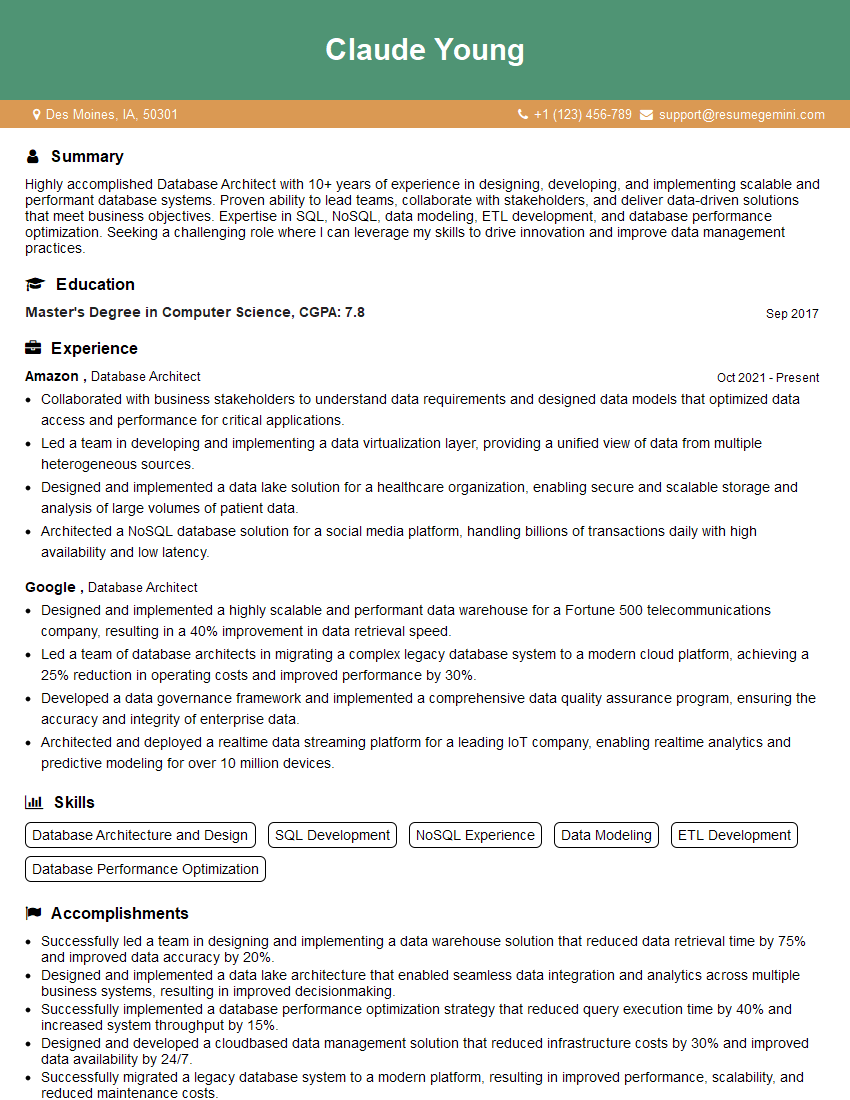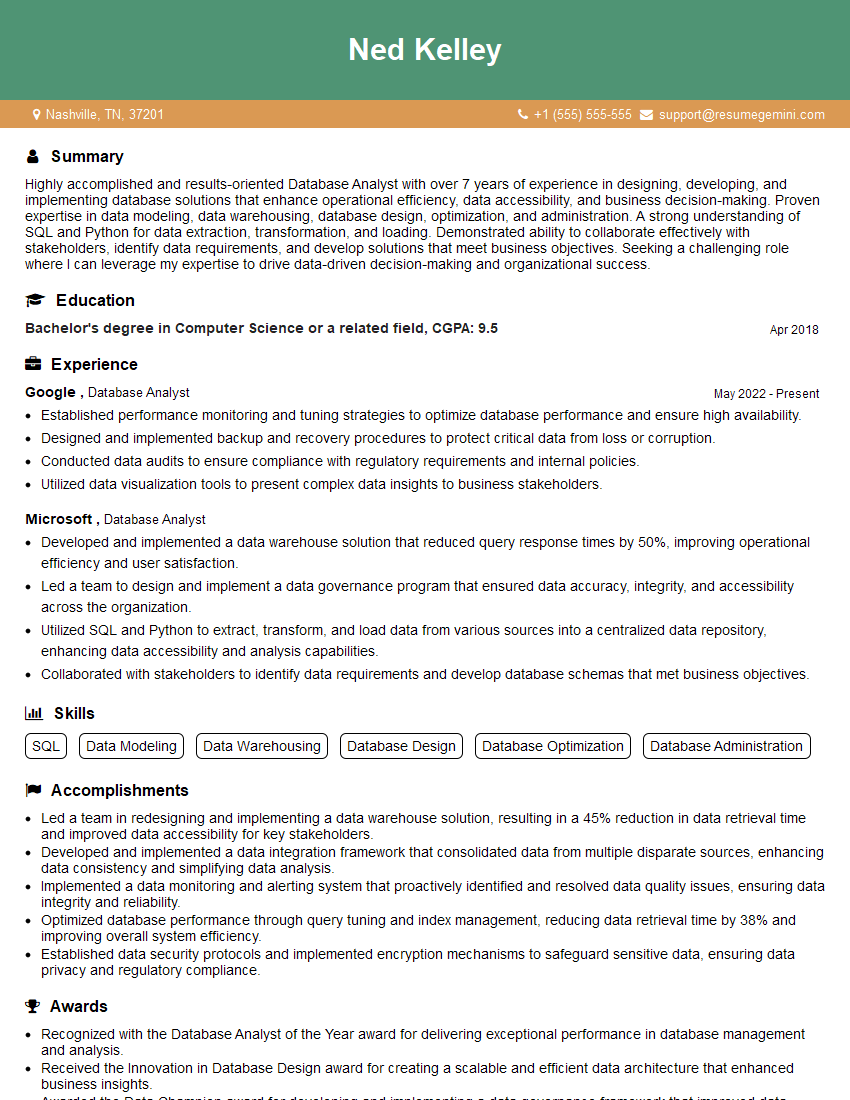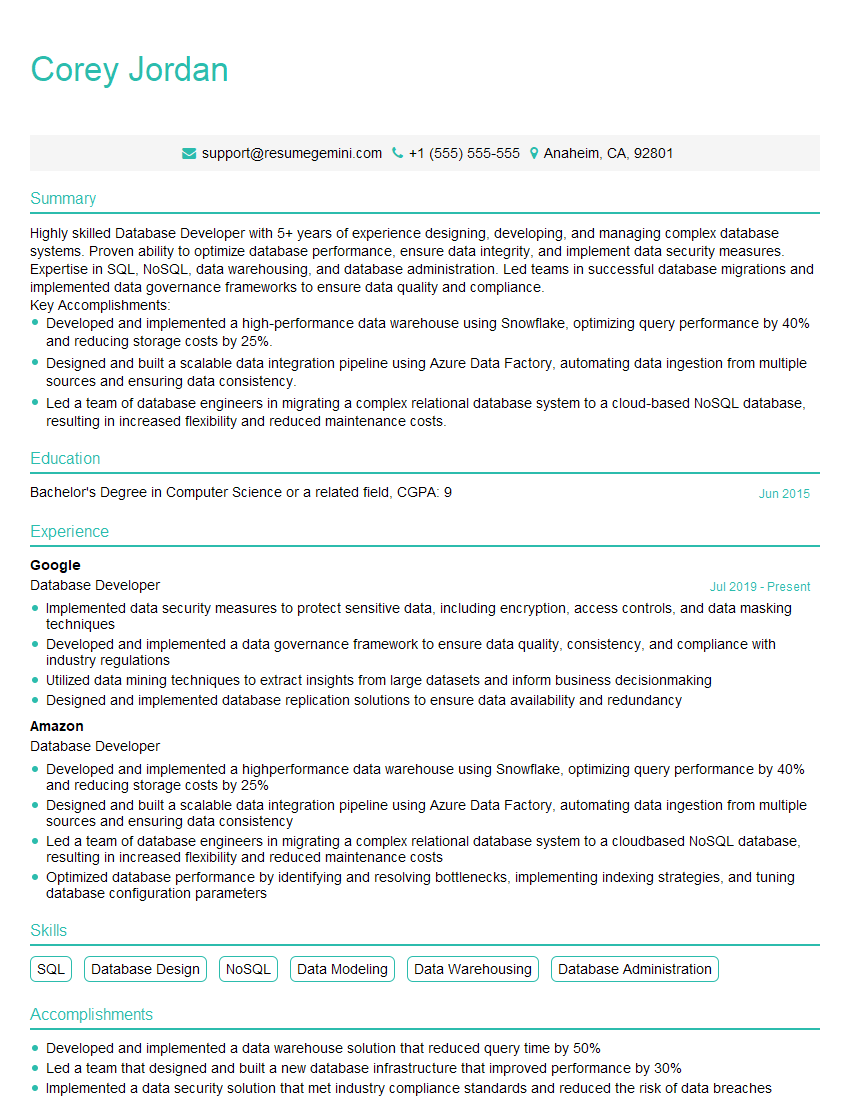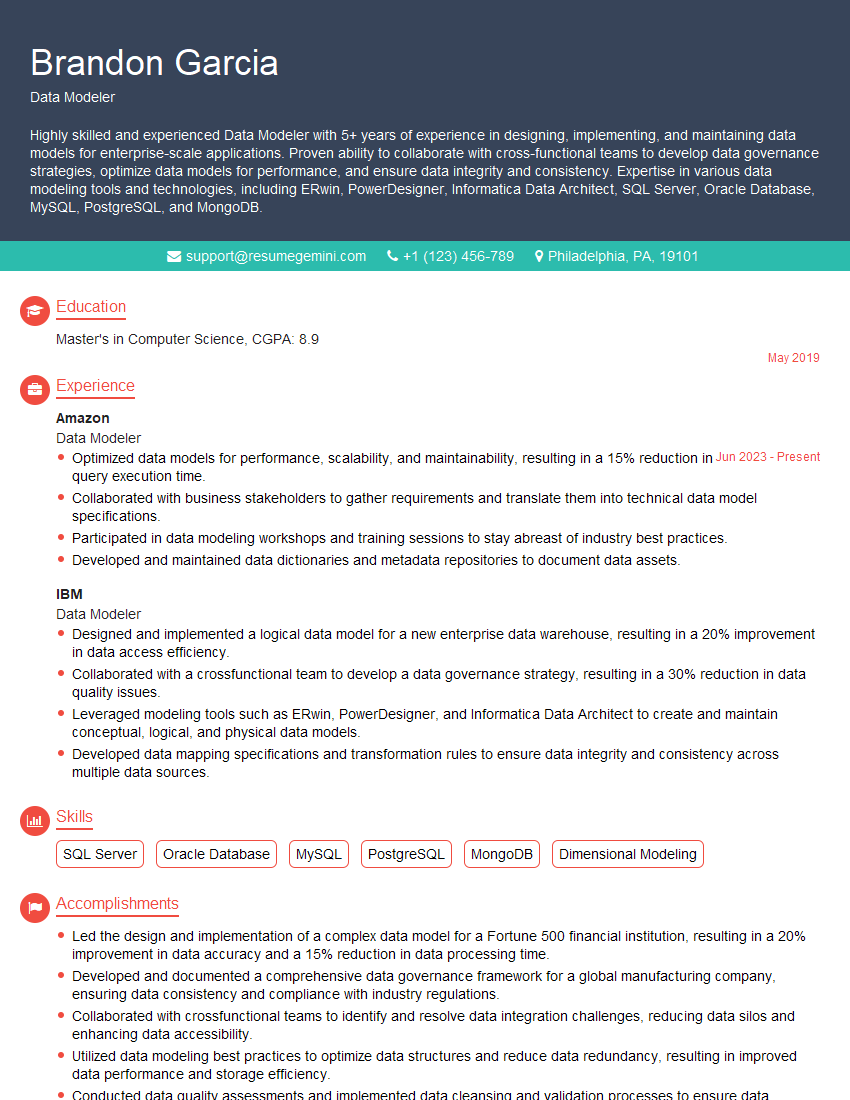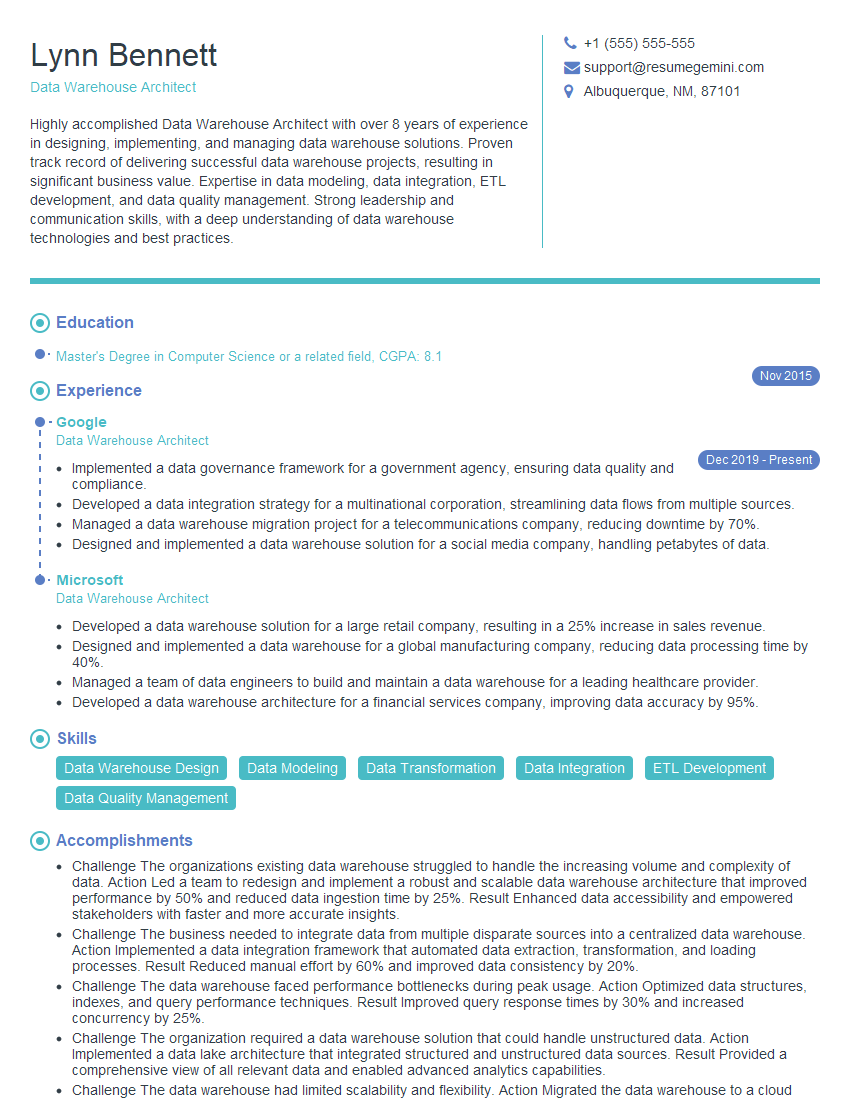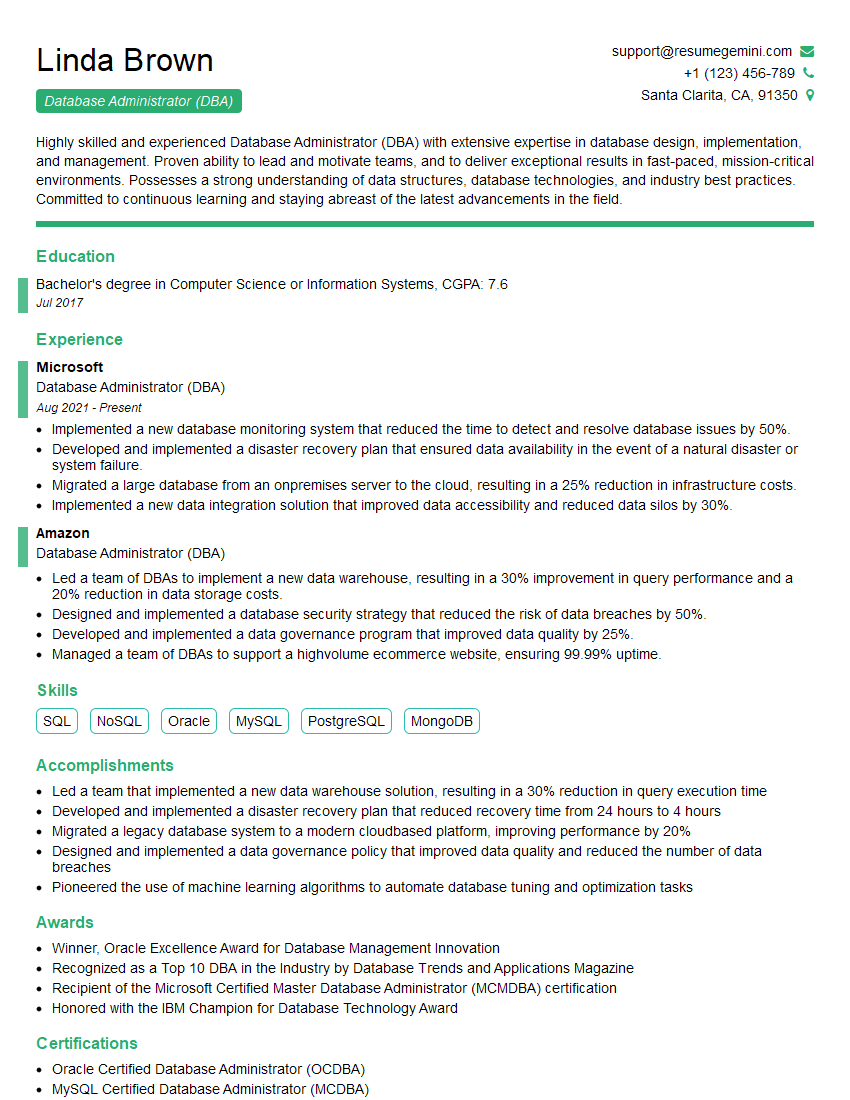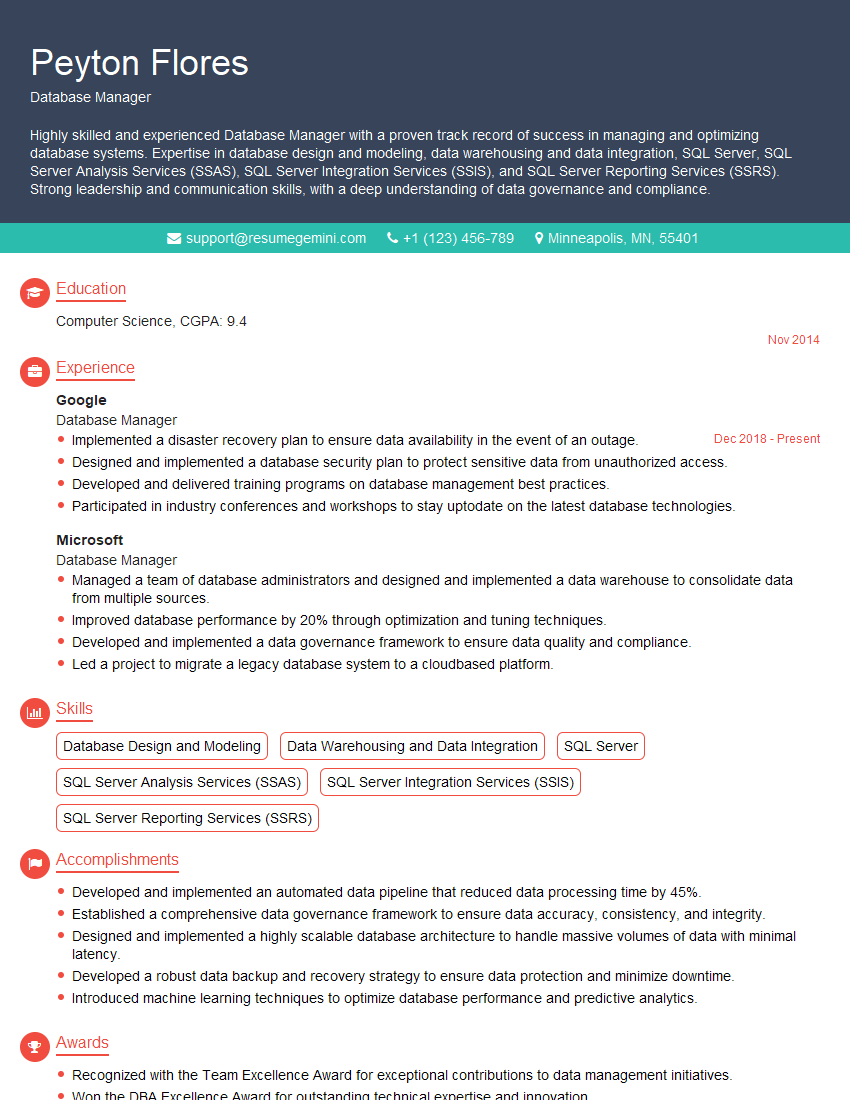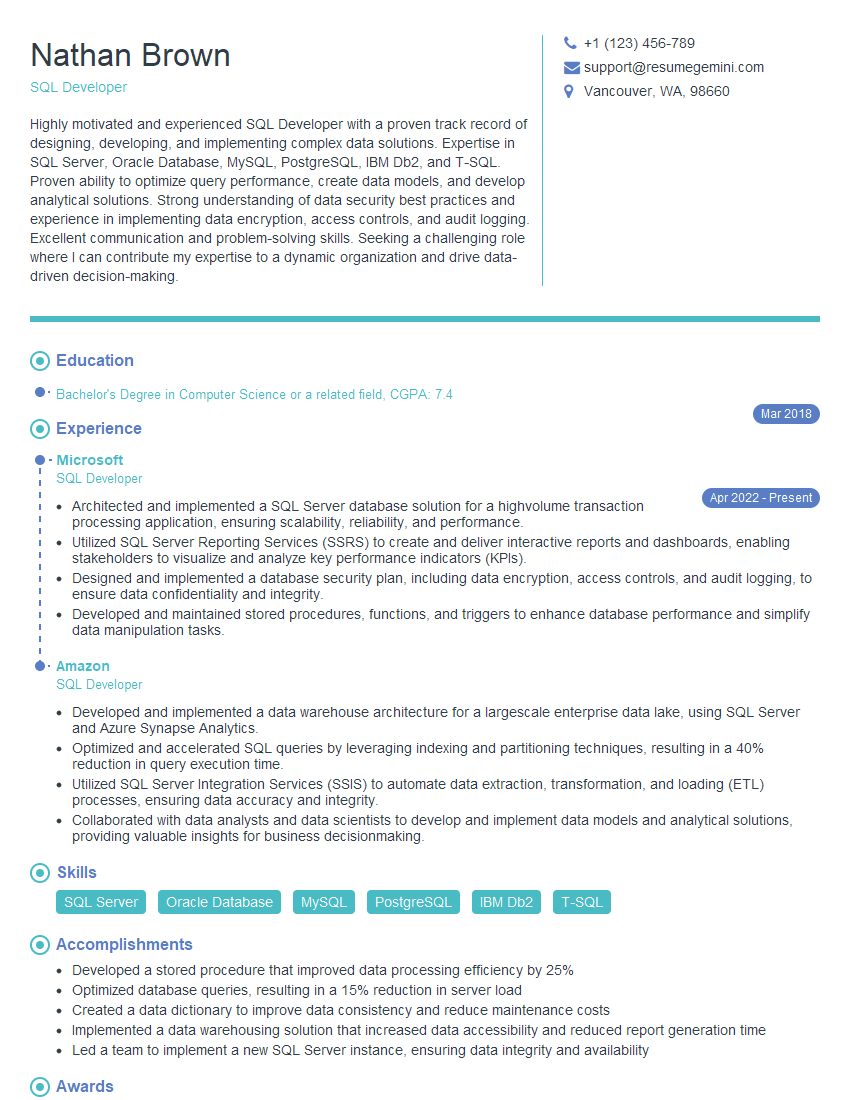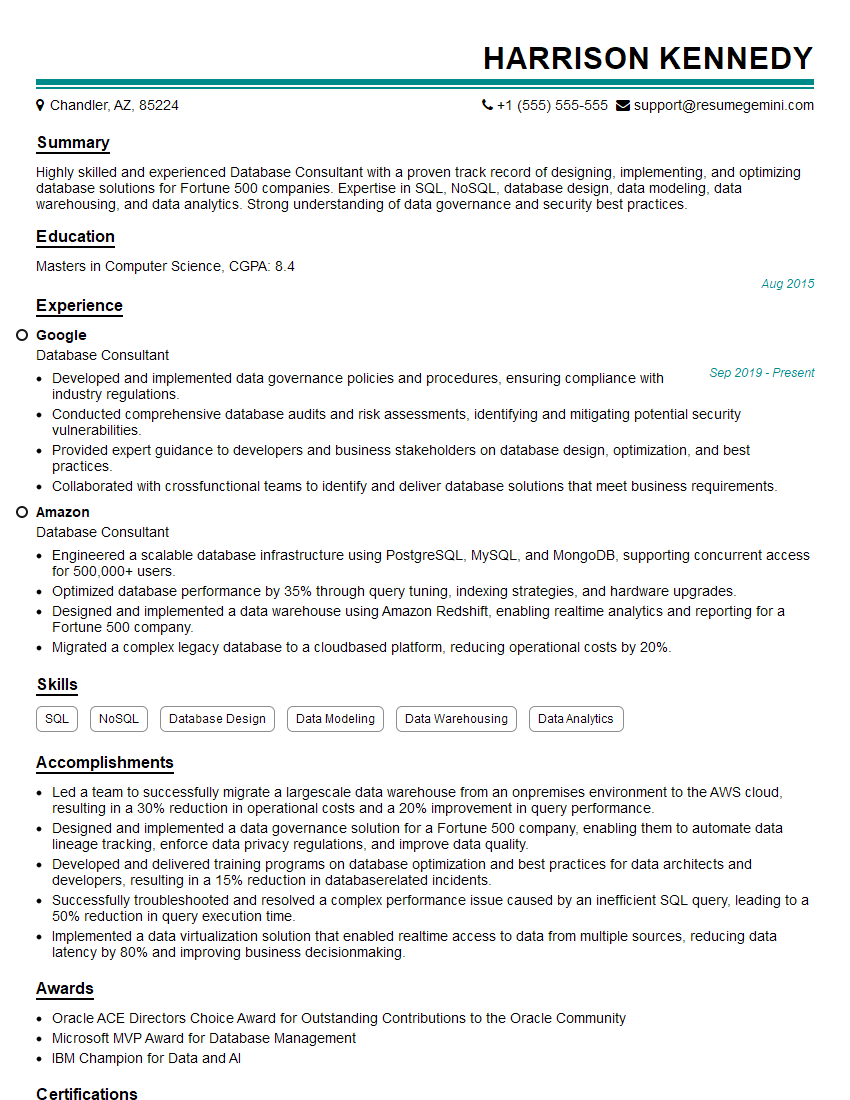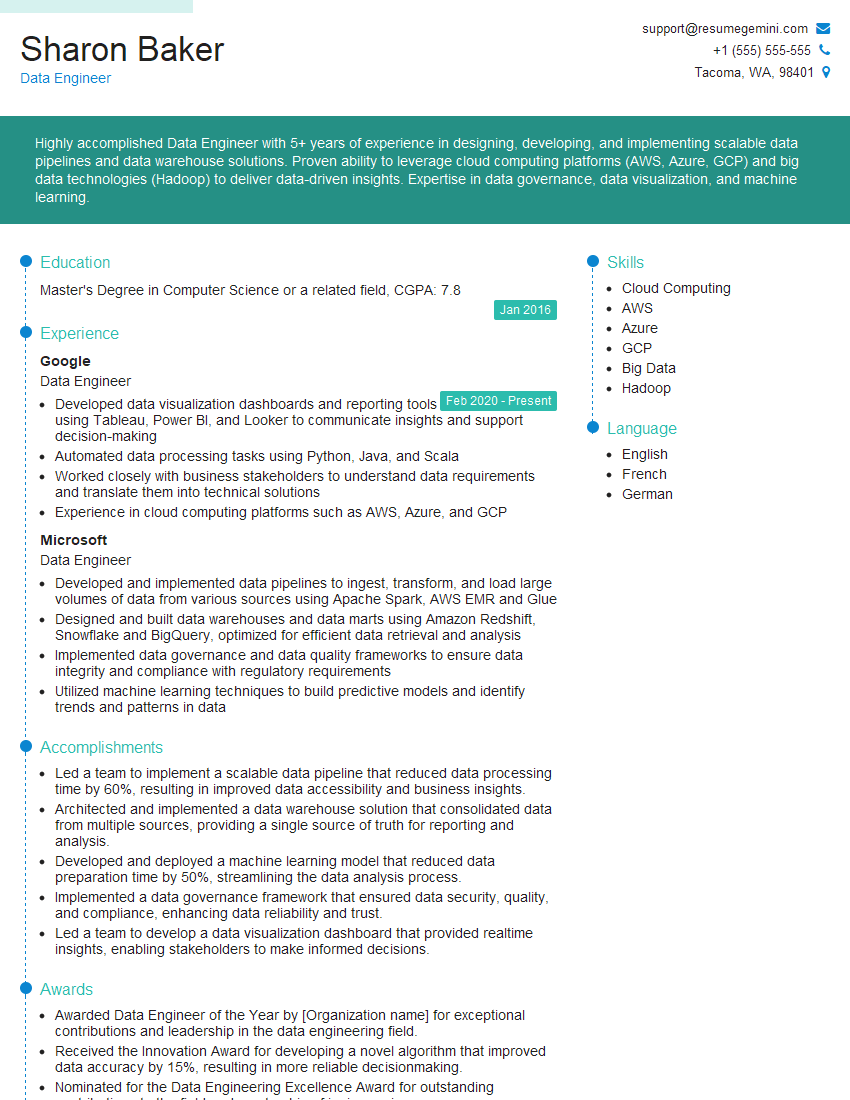Preparation is the key to success in any interview. In this post, we’ll explore crucial Database Management Systems (e.g., Oracle, SQL Server, MySQL) interview questions and equip you with strategies to craft impactful answers. Whether you’re a beginner or a pro, these tips will elevate your preparation.
Questions Asked in Database Management Systems (e.g., Oracle, SQL Server, MySQL) Interview
Q 1. Explain the difference between clustered and non-clustered indexes.
The core difference between clustered and non-clustered indexes lies in how they physically organize data within the database. Imagine a library: a clustered index is like organizing books alphabetically on the shelves – the physical order of the books reflects the index order. A non-clustered index, on the other hand, is like a library catalog; it provides pointers to where books are located but doesn’t dictate the physical arrangement of the books.
Clustered Index: A clustered index sorts data rows physically according to the index key. There can be only one clustered index per table because the data can only be physically sorted in one way. Queries using the clustered index column(s) are incredibly fast, because the database knows exactly where the data resides. Think of this as a perfectly organized library where finding a book based on its title is instantaneous because the shelves are sorted alphabetically.
Non-Clustered Index: A non-clustered index doesn’t dictate the physical order of data. It’s a separate structure containing the index key and a pointer to the location of the actual row in the data file. You can have multiple non-clustered indexes on a table. This is analogous to the library catalog: you can search by author, title, or subject, each leading you to the book’s location, even if the books themselves aren’t organized by those attributes.
Example: Consider a table of employees. If you create a clustered index on the EmployeeID column, the table’s rows will be physically sorted by EmployeeID. If you add a non-clustered index on the LastName column, a separate index structure will store last names along with pointers to the physical row locations. Queries searching by EmployeeID will be extremely efficient, while queries based on LastName will benefit from faster searches but might not be as fast as those using the clustered index.
Q 2. What are ACID properties in database transactions?
ACID properties are a set of four crucial guarantees that ensure database transactions are processed reliably. They are essential for maintaining data integrity, especially in concurrent environments. Think of them as the four pillars supporting the integrity of your database transactions.
- Atomicity: A transaction is treated as a single, indivisible unit of work. Either all changes within the transaction are applied successfully, or none are. It’s an ‘all or nothing’ approach. Imagine transferring money between accounts – either both accounts are updated correctly, or neither is. Partial updates are prevented.
- Consistency: A transaction maintains the database’s integrity constraints. The database starts in a valid state, and the transaction guarantees it remains in a valid state. A classic example would be maintaining the balance in a bank account – every transaction keeps the balance consistent.
- Isolation: Concurrent transactions appear to execute in isolation, as if they are the only transactions running. Other transactions should not see intermediate or incomplete changes made by a transaction in progress. This prevents anomalies such as ‘dirty reads’ or ‘lost updates’.
- Durability: Once a transaction is committed, the changes are permanently stored in the database and survive even system failures. This ensures that data persists even if the system crashes.
Example: In an online store, an order processing transaction must satisfy ACID properties. If an order is successfully placed (Atomicity), the inventory count updates correctly (Consistency), other users can’t see the inconsistent data (Isolation), and the changes are saved even if the server restarts (Durability).
Q 3. Describe different types of database joins (INNER, LEFT, RIGHT, FULL OUTER).
Database joins combine rows from two or more tables based on a related column. Think of them as different ways to link related information. Let’s illustrate this with tables: Customers (CustomerID, Name) and Orders (OrderID, CustomerID, OrderDate).
- INNER JOIN: Returns rows only when there is a match in both tables based on the join condition. It’s like finding the intersection of two sets.
- LEFT (OUTER) JOIN: Returns all rows from the left table (the one specified before
LEFT JOIN) and the matching rows from the right table. If there’s no match in the right table, it returnsNULLvalues for the columns from the right table. It’s like getting all customers and their associated orders, even those without any orders. - RIGHT (OUTER) JOIN: Similar to
LEFT JOINbut returns all rows from the right table and the matching rows from the left table.NULLvalues are returned for missing matches from the left table. This shows all orders, regardless of whether there’s a matching customer (though in practice this scenario is less common). - FULL (OUTER) JOIN: Returns all rows from both tables. If there’s a match, it returns the combined row; otherwise,
NULLvalues are used for the missing columns. It gives a complete picture of all customers and orders, highlighting those missing matches on either side.
SQL Examples (using MySQL syntax, but the concepts apply to other DBMS):
SELECT * FROM Customers INNER JOIN Orders ON Customers.CustomerID = Orders.CustomerID; SELECT * FROM Customers LEFT JOIN Orders ON Customers.CustomerID = Orders.CustomerID; SELECT * FROM Customers RIGHT JOIN Orders ON Customers.CustomerID = Orders.CustomerID; SELECT * FROM Customers FULL OUTER JOIN Orders ON Customers.CustomerID = Orders.CustomerID;
(Note: FULL OUTER JOIN isn’t supported in all database systems. Workarounds often involve using UNION of LEFT JOIN and RIGHT JOIN).
Q 4. How do you optimize database query performance?
Optimizing database query performance involves a multifaceted approach, focusing on several key areas. It’s like tuning a high-performance engine – it takes a combination of strategies to achieve peak performance.
- Proper Indexing: Indexes are crucial. Choose appropriate indexes for frequently queried columns. Consider composite indexes for queries involving multiple columns.
- Query Optimization Techniques: Analyze query execution plans to identify bottlenecks. Use techniques like rewriting queries to improve efficiency (e.g., avoiding
SELECT *, using appropriate join types). Tools such as query analyzers and explain plans within database systems are invaluable here. - Database Design: Proper normalization reduces data redundancy and improves query performance. Avoid redundant joins and unnecessary data retrieval.
- Hardware Resources: Ensure sufficient CPU, memory, and disk I/O resources for the database server. Consider using SSDs for faster data access.
- Caching: Implement database caching mechanisms to store frequently accessed data in memory for faster retrieval. Database systems typically offer built-in caching functionalities.
- Connection Pooling: Avoid frequent database connection establishment and termination. Connection pooling reuses existing connections.
- Data Partitioning: For very large datasets, partitioning the database into smaller, manageable units can significantly improve performance.
- Profiling and Monitoring: Continuously monitor database performance using tools provided by the DBMS or third-party monitoring solutions. Identify and address performance issues proactively.
Example: A poorly written query like SELECT * FROM Employees WHERE LastName LIKE '%Smith%' can be significantly improved by adding an index to the LastName column. Similarly, replacing SELECT * with SELECT EmployeeID, FirstName, LastName when only those columns are needed will reduce the amount of data retrieved.
Q 5. Explain normalization and its different forms (1NF, 2NF, 3NF, BCNF).
Database normalization is a systematic process of organizing data to reduce redundancy and improve data integrity. It’s like tidying up a messy room; you organize things logically to make it easier to find what you need and avoid clutter. Normalization aims to eliminate data anomalies that can arise from redundant data.
- 1NF (First Normal Form): Eliminate repeating groups of data within a table. Each column should contain atomic values (single values). Create separate tables for related data and link them with foreign keys. Example: Instead of having a single column for ‘PhoneNumbers’, have a separate table for phone numbers with a foreign key linking to the main table.
- 2NF (Second Normal Form): Be in 1NF and eliminate redundant data that depends on only part of the primary key (partial dependencies). Example: If a table has a composite key (e.g., OrderID, ProductID), and the ProductName only depends on ProductID, move ProductName into a separate table.
- 3NF (Third Normal Form): Be in 2NF and eliminate transitive dependencies. A transitive dependency occurs when a non-key attribute depends on another non-key attribute. Example: If you have a table with CustomerID, City, and State, and City determines State, State should be moved to a separate table.
- BCNF (Boyce-Codd Normal Form): A stricter version of 3NF. For every dependency, the determinant must be a candidate key. This handles a specific type of redundancy not addressed by 3NF.
Real-world Example: Imagine a customer order database. 1NF ensures each order is a separate row, not crammed into one cell. 2NF avoids storing customer address repeatedly for multiple orders, instead creating a separate table for customer addresses. 3NF ensures that product details aren’t duplicated in every order.
Q 6. What are stored procedures and how are they used?
Stored procedures are pre-compiled SQL code blocks that can be stored and reused within a database. Think of them as reusable functions or subroutines for your database. They improve performance, security, and code maintainability.
Benefits:
- Improved Performance: Pre-compilation means faster execution than repeatedly parsing and compiling the same SQL code.
- Enhanced Security: Stored procedures can restrict access to database objects, granting only necessary permissions to users instead of direct access to tables.
- Reduced Network Traffic: Instead of sending multiple SQL statements, you send a single call to the stored procedure.
- Code Reusability: A stored procedure can be used repeatedly by multiple applications or users.
- Data Integrity: Stored procedures help maintain data integrity by enforcing business rules and validation logic within the procedure.
Usage: Stored procedures are called from application code using appropriate database APIs or libraries. They can accept input parameters, perform database operations, and return output parameters or result sets. They are invaluable for encapsulating complex database logic, making your application code cleaner and more manageable.
Example (SQL Server):
CREATE PROCEDURE GetCustomersByName @Name VARCHAR(255) AS BEGIN SELECT * FROM Customers WHERE Name LIKE '%' + @Name + '%'; END;
This procedure takes a name as input and retrieves customers matching that name. Applications can then call this procedure to get customers’ information without needing to write the SQL query repeatedly.
Q 7. How do you handle database concurrency issues?
Database concurrency issues arise when multiple users or transactions access and modify the same data simultaneously. If not properly handled, this can lead to data inconsistencies and anomalies. It’s like having multiple people trying to edit the same document at the same time – you could end up with a corrupted or nonsensical final version.
Several mechanisms address concurrency issues:
- Locking: Database systems use locking mechanisms to control access to data. Shared locks allow multiple readers but prevent writers. Exclusive locks allow only one writer. Different locking granularities (row-level, page-level, table-level) offer trade-offs between concurrency and overhead.
- Transactions and ACID Properties: Using transactions with ACID properties ensures that data modifications are atomic, consistent, isolated, and durable, preventing concurrency problems.
- Optimistic Locking: This approach assumes that conflicts are rare. It checks for changes before committing an update. If changes have occurred, the transaction is rolled back, and the user needs to retry.
- Pessimistic Locking: This approach assumes that conflicts are frequent. It acquires locks proactively before starting an update, preventing other users from accessing the data.
- MVCC (Multi-Version Concurrency Control): MVCC maintains multiple versions of the data, allowing concurrent transactions to see different versions without blocking each other. This is a popular approach to manage concurrency, enhancing concurrency without sacrificing isolation.
Example: Consider two users trying to update the same bank account balance concurrently. Using appropriate locking mechanisms prevents one update from overwriting the other, maintaining the consistency of the account balance. If one user acquires an exclusive lock, the second user’s update will wait until the lock is released.
Q 8. What is deadlock and how do you prevent it?
A deadlock is a situation in a database system where two or more transactions are blocked indefinitely, waiting for each other to release the resources that they need. Imagine two people trying to pass each other in a narrow hallway – neither can move until the other moves first. This creates a standstill.
To prevent deadlocks, we employ several strategies:
- Careful Ordering of Locks: If transactions acquire locks in a consistent order across all resources, deadlocks are less likely. For example, always lock table A before table B, regardless of the specific operation.
- Shortest Transaction First: Prioritize shorter transactions to reduce the time resources are held. The shorter the transaction, the lower the probability it will create a deadlock.
- Timeout Mechanisms: Set a time limit for a transaction to acquire all necessary locks. If the timeout expires, the transaction is rolled back, releasing its resources and preventing a potential deadlock. This is a common practice to avoid indefinite waits.
- Deadlock Detection and Recovery: Database systems often have built-in deadlock detection mechanisms. When a deadlock is detected, the database system chooses one transaction to roll back (abort), freeing the resources and allowing other transactions to proceed. This rollback is automatic in most systems.
- Transaction Isolation Levels: Using more restrictive isolation levels (e.g., Serializable) can help reduce the risk of deadlocks, although it might impact concurrency.
Example: Suppose Transaction 1 needs to update records in Table A and then Table B, and Transaction 2 needs to update records in Table B and then Table A. If Transaction 1 locks Table A and Transaction 2 locks Table B, then a deadlock occurs.
Q 9. Explain different types of database backups and recovery strategies.
Database backups are crucial for data protection and recovery. There are several types:
- Full Backup: A complete copy of the entire database at a specific point in time. This is the most comprehensive but also the slowest backup type.
- Differential Backup: Backs up only the data that has changed since the last full backup. Faster than a full backup, and recovery involves restoring the full backup and then the differential backup.
- Incremental Backup: Backs up only the data that has changed since the last backup (full or incremental). The fastest, but recovery requires restoring the full backup, and then each incremental backup in sequence.
- Transaction Log Backup: A record of all transactions (inserts, updates, deletes) since the last backup. This is crucial for point-in-time recovery.
Recovery strategies depend on the backup types used:
- Full Backup + Transaction Log: Provides the most granular point-in-time recovery.
- Full Backup + Differential Backup: Faster recovery than full + transaction log, but less granular.
- Full Backup + Incremental Backups: Similar to differential, but potentially many incremental backups to restore.
The choice of backup type and strategy depends on the Recovery Time Objective (RTO) and Recovery Point Objective (RPO) – how quickly you need to recover and how much data loss you can tolerate.
Q 10. What are triggers and how do you use them?
Triggers are stored procedures that automatically execute in response to certain events on a particular table or view in a database. They’re like automated actions that happen behind the scenes.
Think of them as event listeners. When a specific event occurs (like inserting a new row), the trigger’s code is automatically executed.
Types of Triggers:
- Before Triggers: Execute before the triggering event (INSERT, UPDATE, DELETE) and can modify the data before it’s committed to the table.
- After Triggers: Execute after the triggering event and generally perform auditing or logging functions.
Example (SQL Server):
CREATE TRIGGER AuditEmployeeChanges ON Employees
AFTER UPDATE, DELETE
AS
BEGIN
--Insert audit trail information into an audit table
END;This trigger logs all updates and deletes on the Employees table. You can use triggers for tasks like:
- Auditing and Logging: Recording changes to the database.
- Data Validation: Ensuring data integrity before changes are made.
- Cascading Actions: Automatically updating related tables.
- Enforcing Business Rules: Applying custom rules to data.
Q 11. How do you ensure database security?
Database security is paramount. It involves a multi-layered approach:
- Access Control: Restricting access to the database based on user roles and privileges using features like user accounts, roles, and permissions. The principle of least privilege should be applied – users should only have access to the data they absolutely need.
- Data Encryption: Encrypting sensitive data both at rest (on storage) and in transit (over the network) to protect it from unauthorized access. Encryption keys must be managed securely.
- Network Security: Protecting the database server from network attacks through firewalls, intrusion detection systems, and regular security audits. The server itself should be hardened to protect from vulnerabilities.
- Input Validation: Sanitizing user input to prevent SQL injection attacks – one of the most common database vulnerabilities.
- Regular Backups and Recovery Plans: This is a critical aspect of security and business continuity.
- Auditing and Monitoring: Regularly audit database activity to detect suspicious behavior. Implement monitoring tools to alert to potential security breaches.
- Patching and Updates: Keep the database software, server operating system, and all related components up-to-date with the latest security patches.
In addition, strong password policies, regular security assessments, and employee training are also essential.
Q 12. What are views and why are they useful?
A view is a virtual table based on the result-set of an SQL statement. It doesn’t contain any data of its own; instead, it presents a customized view of the data from one or more underlying base tables.
Benefits of Views:
- Simplified Queries: Views can simplify complex queries by creating a simpler, more manageable interface to the underlying data. A complex join can be hidden behind a simple view.
- Data Security: Views can restrict access to sensitive data by only exposing a subset of columns or rows. A user might only be granted access to a view, not the underlying table.
- Data Abstraction: Views hide the complexity of the underlying database schema from users. The structure of the underlying tables can change, but the view remains consistent as long as the view’s underlying SQL remains valid.
- Maintainability: Changes to the underlying table’s structure might require updates to the view’s definition. It simplifies the process of maintaining data security and consistency.
Example: A view could be created to show only customer information relevant to a sales team, without exposing other sensitive data in the main customer table.
Q 13. Explain the concept of indexing and its benefits.
An index is a special lookup table that the database search engine can use to speed up data retrieval. Simply put, it’s like an index in the back of a book – it helps you quickly locate specific information.
Benefits of Indexing:
- Faster Data Retrieval: Indexes significantly speed up query performance, especially on large tables, by allowing the database to quickly locate the relevant rows without scanning the entire table.
- Improved Query Performance: Indexes improve the overall performance of database queries, leading to faster application response times.
- Enhanced Concurrency: Indexes can reduce the amount of time that locks are held, allowing for increased concurrency in the database.
Trade-offs: While indexes improve query performance, they add overhead during data modifications (inserts, updates, deletes). Therefore, it’s crucial to choose the right columns to index carefully.
Types of Indexes: There are many types of indexes (B-tree, hash, full-text, etc.), each with its own strengths and weaknesses. The choice depends on the database system and specific application requirements.
Q 14. What are the different types of database relationships?
Database relationships define how different tables in a database are related to each other. They ensure data integrity and consistency.
- One-to-One (1:1): Each record in one table is related to only one record in another table, and vice versa. Example: A person and their passport.
- One-to-Many (1:M) or Many-to-One (M:1): One record in a table can be related to many records in another table. Example: A customer (one) can have many orders (many).
- Many-to-Many (M:N): Records in one table can be related to many records in another table, and vice versa. This relationship requires a junction table. Example: Students (many) can take many courses (many).
These relationships are implemented using foreign keys. A foreign key in one table references the primary key of another table, establishing the link between them.
Q 15. Describe your experience with database replication and high availability.
Database replication and high availability are crucial for ensuring data redundancy and continuous application access. Replication involves copying data from a primary database server to one or more secondary servers. This provides several benefits, including disaster recovery, improved read performance, and increased scalability. High availability, on the other hand, focuses on minimizing downtime by ensuring the database is always accessible. This is typically achieved through techniques like replication, clustering, and failover mechanisms.
In my experience, I’ve worked extensively with various replication technologies. For instance, I’ve implemented asynchronous replication in MySQL using tools like MySQL Replication, providing near real-time data mirroring to geographically distributed servers for improved data accessibility across regions. In Oracle, I’ve utilized Data Guard for synchronous replication, achieving extremely high availability with minimal data loss during failover scenarios. For SQL Server, I’ve leveraged AlwaysOn Availability Groups, which provides high availability and disaster recovery by creating a cluster of SQL Server instances. The choice of replication method (synchronous vs. asynchronous) depends greatly on the application’s requirements for data consistency versus performance.
For high availability, I’ve set up clustering solutions using both vendor-specific tools and third-party solutions. For example, I used Pacemaker in a Linux environment to manage failover between database servers within a cluster. These setups ensure minimal disruption in case of a server failure. Understanding RTO (Recovery Time Objective) and RPO (Recovery Point Objective) is vital when designing high availability systems. I always work closely with the application team to understand their tolerance for downtime and data loss to design a robust and appropriate solution.
Career Expert Tips:
- Ace those interviews! Prepare effectively by reviewing the Top 50 Most Common Interview Questions on ResumeGemini.
- Navigate your job search with confidence! Explore a wide range of Career Tips on ResumeGemini. Learn about common challenges and recommendations to overcome them.
- Craft the perfect resume! Master the Art of Resume Writing with ResumeGemini’s guide. Showcase your unique qualifications and achievements effectively.
- Don’t miss out on holiday savings! Build your dream resume with ResumeGemini’s ATS optimized templates.
Q 16. How do you monitor and troubleshoot database performance issues?
Monitoring and troubleshooting database performance issues is a critical aspect of database administration. It involves proactively identifying bottlenecks and resolving performance problems to maintain optimal system efficiency. My approach involves a multi-pronged strategy.
- Performance Monitoring Tools: I utilize a combination of built-in database monitoring tools (like Oracle’s AWR reports, SQL Server’s DMVs, or MySQL’s performance schema) and third-party tools (e.g., Prometheus, Grafana) to collect performance metrics such as CPU usage, I/O wait times, memory usage, and query execution times. These tools provide valuable insights into database behavior and potential bottlenecks.
- Query Analysis: I use query analyzers to identify slow-running queries that significantly impact performance. I analyze query plans to pinpoint inefficiencies and optimize them through indexing, query rewriting, or parameterization. For instance, I frequently use Oracle’s SQL Developer or SQL Server Management Studio to examine execution plans and identify opportunities for improvement.
- Log Analysis: Analyzing database logs, including error logs, transaction logs, and audit logs, helps identify errors, exceptions, and unusual activities that could be affecting performance. This can reveal clues about unexpected behaviour and help narrow down the source of issues.
- Resource Management: I ensure proper resource allocation to the database server, including CPU, memory, and storage. This involves configuring appropriate resource limits and monitoring resource utilization to avoid contention and starvation.
- Regular Maintenance: Regular database maintenance tasks, such as indexing, statistics updates, and cleanup, are vital for maintaining optimal performance. Neglecting this can lead to gradual performance degradation.
For example, I once identified a slow-running query that was responsible for a significant performance bottleneck in a large e-commerce application. By analyzing the query execution plan, I found that a missing index was the root cause. Adding the index improved the query execution time by several orders of magnitude and resolved the performance issue. The key is to be proactive, employing a combination of monitoring, analysis, and preventative measures to ensure the database operates smoothly.
Q 17. What is a transaction log and its importance?
A transaction log is a crucial component of a database system, acting as a chronological record of all database modifications. Think of it as a detailed journal that keeps track of every write operation, including inserts, updates, and deletes. Its importance lies in its role in data integrity and recovery.
- Data Integrity: The transaction log ensures data consistency by recording all changes in a way that allows the database to be rolled back to a consistent state in case of failure. This is achieved through the concept of atomicity, where transactions are treated as indivisible units of work.
- Recovery: In the event of a system crash or hardware failure, the transaction log enables the database to recover to a point in time before the failure. By replaying the log entries, the database can reconstruct its state to minimize data loss. This is critical for maintaining data reliability.
- Point-in-Time Recovery: The transaction log allows for point-in-time recovery, meaning the database can be restored to a specific point in time, rather than just the last full backup. This enables faster recovery and minimizes data loss.
- Auditing: Transaction logs can also be used for auditing purposes, providing a historical record of database changes. This is important for regulatory compliance and security.
For example, if a transaction involving several updates fails midway through, the transaction log ensures that only the changes completed before the failure are applied. The partially completed changes are undone (rolled back), maintaining the data’s consistency. Without a transaction log, such a failure could leave the database in an inconsistent and unrecoverable state. The log is a fundamental building block for ensuring reliability and data integrity in any database system.
Q 18. Explain the difference between DELETE and TRUNCATE commands.
Both DELETE and TRUNCATE commands remove data from a table, but they differ significantly in how they operate and their implications.
DELETE: This command removes rows based on specified conditions (or all rows if no condition is given). It is a logged operation, meaning each row deletion is recorded in the transaction log. This allows for the possibility of rolling back the changes if needed.DELETEis typically slower thanTRUNCATEdue to the logging overhead.TRUNCATE: This command removes all rows from a table without logging each individual row deletion. It is a faster operation thanDELETEbecause it doesn’t involve individual row logging.TRUNCATEcannot be rolled back, and it also resets the auto-increment counter for the table (if applicable). In most cases, permissions required toTRUNCATEare greater than forDELETE.
Here’s a simple example illustrating the difference:
DELETE FROM MyTable WHERE column1 = 'value'; (Deletes only rows matching the condition)
TRUNCATE TABLE MyTable; (Deletes all rows from the table)
The choice between DELETE and TRUNCATE depends on the specific requirements. If you need to selectively remove rows and have rollback capabilities, use DELETE. If you need to quickly remove all rows from a table and don’t require rollback, TRUNCATE is generally more efficient.
Q 19. How familiar are you with data warehousing concepts?
Data warehousing is a critical aspect of business intelligence. It involves the extraction, transformation, and loading (ETL) of data from various operational databases and other sources into a centralized data warehouse. This warehouse is specifically designed for analytical processing, enabling organizations to gain valuable insights from their data.
My familiarity with data warehousing concepts encompasses designing dimensional models (star schema, snowflake schema), understanding ETL processes, and working with data warehousing tools. I’ve worked with various ETL tools, such as Informatica PowerCenter and SSIS (SQL Server Integration Services). I understand the importance of data cleansing, transformation, and data quality in creating a reliable and accurate data warehouse. Moreover, I have experience in performance tuning and optimizing queries on data warehouses for efficient analytical processing using tools and technologies such as OLAP cubes.
In a past project, I was involved in designing and implementing a data warehouse for a large retail company. This involved extracting sales data, customer data, and product data from various transactional databases, transforming it to fit the dimensional model, and loading it into a data warehouse for business analysis. This enabled the company to gain insights into sales trends, customer behavior, and product performance, leading to improved business decisions.
Q 20. What are your experiences with different database management systems (e.g., Oracle, SQL Server, MySQL, PostgreSQL)?
I have extensive experience with several database management systems, including Oracle, SQL Server, MySQL, and PostgreSQL. My experience isn’t limited to just basic CRUD operations; it extends to advanced features and performance tuning in each system.
- Oracle: I’ve worked extensively with Oracle Database, mastering its features like RAC (Real Application Clusters) for high availability, Data Guard for replication, and its advanced performance tuning capabilities, including AWR reports and SQL tuning advisor.
- SQL Server: My SQL Server experience encompasses using AlwaysOn Availability Groups for high availability, implementing SSIS for ETL processes, and utilizing DMVs (Dynamic Management Views) for performance monitoring and troubleshooting.
- MySQL: I’m proficient in MySQL, including replication technologies, performance tuning with the performance schema, and working with various storage engines like InnoDB and MyISAM. I have experience scaling MySQL deployments both vertically and horizontally.
- PostgreSQL: I’ve worked with PostgreSQL, leveraging its advanced features like extensions and its robust JSON support. I’m familiar with its performance tuning techniques and different data types.
The choice of database system depends on the specific needs of the project, including scalability requirements, cost considerations, and the application’s specific features. I can effectively leverage the strengths of each system to deliver optimal database solutions.
Q 21. Explain your experience with database design and modeling.
Database design and modeling are fundamental to creating efficient and reliable database systems. My approach involves understanding the business requirements, translating them into a logical data model, and then implementing a physical database design.
I typically utilize Entity-Relationship Diagrams (ERDs) to represent the logical data model, clearly defining entities, attributes, and relationships between them. I then translate this logical model into a physical design, considering factors such as data types, indexing strategies, normalization, and database constraints. I utilize tools like ERWin Data Modeler and SQL Server Management Studio for designing and documenting the database schema.
A key aspect of my design process is normalization. I strive for a well-normalized database to reduce data redundancy and ensure data integrity. I also consider performance aspects during the design phase, ensuring efficient indexing and query optimization. I understand the importance of considering scalability and future growth when designing the database, so that it can adapt to the evolving needs of the application.
For example, in a recent project involving a social networking platform, I designed a database schema that efficiently handled millions of users and their connections. This involved carefully selecting data types, implementing appropriate indexing strategies, and optimizing the database for high-throughput operations. The outcome was a highly scalable and performant database supporting the application’s demands.
Q 22. How do you handle large datasets and improve query efficiency?
Handling large datasets and improving query efficiency is crucial for any database system. Think of it like navigating a massive library – you need a strategic approach to find the book (data) you need quickly. This involves a multi-pronged strategy:
Indexing: Indexes are like the library’s catalog. They create pointers to data, significantly speeding up searches. For instance, adding an index on a frequently queried column (e.g., customer ID) will drastically improve the speed of retrieving customer information. Different index types (B-tree, hash, etc.) are optimized for various query patterns.
Query Optimization: This involves analyzing SQL queries to identify and eliminate inefficiencies. Tools like database explain plans show the query execution path, helping identify bottlenecks. For example, avoiding full table scans by using appropriate indexes and joins is essential. Sometimes rewriting a query slightly can dramatically improve performance.
Database Tuning: This involves adjusting database settings (e.g., buffer pool size, memory allocation) to optimize performance. It’s like adjusting the library’s layout for better workflow. Proper configuration ensures optimal resource utilization.
Data Partitioning and Sharding: For extremely large datasets, distributing data across multiple servers (sharding) or partitioning it within a single server based on criteria (partitioning) is necessary. Imagine splitting the library into multiple smaller, manageable units, each handling a specific category of books. This improves scalability and query performance by reducing the amount of data processed by individual servers.
Materialized Views: These are pre-computed results of complex queries, stored as tables. They’re like pre-prepared summaries of frequently accessed data, saving time on repetitive calculations. They’re particularly useful for reporting and analytical queries.
In a project I worked on involving a customer relationship management (CRM) system with millions of records, implementing these strategies reduced query times from several minutes to a few seconds, significantly improving user experience.
Q 23. Describe your experience with ETL processes.
ETL (Extract, Transform, Load) processes are the backbone of any data warehouse or data lake. It’s like building a new, organized library from multiple sources. My experience includes designing and implementing ETL pipelines using various tools.
Extract: This involves extracting data from various sources – databases, flat files, APIs, etc. I’ve used tools like Apache Sqoop for extracting data from relational databases and Talend for handling diverse sources.
Transform: This is where data cleaning, validation, and transformation occur. This could include data type conversions, handling missing values, data deduplication, and enriching data with external sources. I have extensive experience using scripting languages like Python and SQL for data manipulation within the transformation stage.
Load: Finally, the transformed data is loaded into the target system – typically a data warehouse or data lake. I’ve worked with various loading techniques, optimizing for speed and efficiency depending on the target system’s characteristics.
In one project, I implemented an ETL pipeline to migrate customer data from a legacy system to a modern data warehouse. The pipeline ensured data integrity, handled inconsistencies, and improved data accessibility for reporting and analytics. I used a scheduling tool to automate the process, ensuring regular data updates.
Q 24. What are your experiences with NoSQL databases?
NoSQL databases are a great alternative to traditional relational databases when dealing with large volumes of unstructured or semi-structured data. They’re like specialized libraries designed for specific types of collections – not everything fits neatly on a shelf. My experience spans several NoSQL database types:
Document databases (MongoDB): Ideal for storing JSON-like documents, excellent for applications needing flexible schemas and high scalability.
Key-value stores (Redis): Great for caching and session management due to their extremely fast read and write speeds.
Graph databases (Neo4j): Perfect for managing relationships between data points. Useful for social networks, recommendation systems, and knowledge graphs.
I’ve used MongoDB to build a real-time analytics dashboard, leveraging its scalability to handle high-volume data streams. The flexibility of its schema allowed us to quickly adapt to evolving data requirements.
Q 25. What is your approach to database capacity planning?
Database capacity planning is crucial for ensuring database performance and availability. It’s akin to planning the size and layout of a new library to anticipate future needs. My approach involves:
Data Growth Projections: Forecasting future data volume based on historical trends, business growth, and expected data generation rates.
Workload Analysis: Analyzing the types and frequency of database queries and transactions to determine resource requirements.
Hardware Sizing: Determining the appropriate server specifications (CPU, memory, storage) based on workload analysis and data growth projections. This includes considering factors like disk I/O, network bandwidth and CPU utilization.
Performance Testing: Simulating expected workloads to assess database performance under realistic conditions. This helps identify potential bottlenecks before they become production issues.
In a previous role, I used capacity planning techniques to ensure our database could handle a significant increase in user traffic during a major marketing campaign. By accurately projecting data growth and conducting performance testing, we avoided any performance degradation and ensured a successful campaign.
Q 26. Explain your understanding of database sharding and partitioning.
Database sharding and partitioning are techniques used to improve scalability and performance of large databases. Imagine splitting a massive library into smaller, more manageable sections.
Sharding: Distributes data across multiple database servers, each managing a subset of the data. This is suitable for very large databases needing high availability and scalability. It’s like having multiple independent libraries, each specializing in different subjects.
Partitioning: Divides data within a single database server into smaller, manageable units. This improves performance by reducing the amount of data processed for individual queries. It’s like organizing the books within a single library into logical sections (fiction, non-fiction, etc.). Different partitioning strategies exist (range, hash, list).
Choosing between sharding and partitioning depends on specific needs. Sharding is better for massive scale-out, whereas partitioning is effective for improving performance within a single server. I’ve used both in various projects to optimize database performance based on the specific dataset and workload characteristics.
Q 27. How do you ensure data integrity and consistency?
Data integrity and consistency are paramount. It’s like ensuring the library’s catalog is always accurate and up-to-date, with no missing or contradictory information. My approach includes:
Constraints: Using database constraints (e.g., primary keys, foreign keys, unique constraints, check constraints) to enforce data validity and relationships. These are like rules ensuring the data conforms to predefined standards.
Transactions: Employing transactions to ensure that multiple database operations are treated as a single, atomic unit. If any part of a transaction fails, the entire transaction is rolled back, maintaining data consistency. It’s like making sure all changes to the library’s catalog happen atomically – no partial updates.
Data Validation: Implementing data validation rules at the application level and database level to prevent invalid data from being entered into the database. This is like having a librarian check the information before adding a new book to the catalog.
Auditing: Tracking changes to the database to maintain an audit trail, enabling tracking data modifications, useful for compliance and troubleshooting.
Backup and Recovery: Implementing regular backups and a robust recovery plan to protect against data loss. This ensures the library has a copy in case of disaster.
In a financial application, maintaining data integrity was crucial. We implemented stringent constraints, transactions, and auditing to ensure the accuracy and reliability of financial records, complying with regulatory requirements.
Q 28. Describe your experience with database migration.
Database migration is a complex process, like moving an entire library to a new building. My experience involves various migration techniques:
In-place Upgrade: Updating the database version directly on the existing server. This is the simplest approach but can be risky and may require downtime.
Parallel Migration: Setting up a new database server, replicating the data, and switching over once the new system is ready. This minimizes downtime, but requires careful planning and execution.
Data Extraction and Transformation: Extracting data from the old system, transforming it to the format required by the new system, and then loading it into the new database. This method offers flexibility but can be time-consuming.
For a large-scale migration project from Oracle to PostgreSQL, we employed a parallel migration strategy. We carefully planned the cutover process, ensuring minimal disruption to ongoing operations and implementing a comprehensive rollback plan in case of issues.
Key considerations for any migration include: downtime planning, data validation, testing, and a thorough rollback strategy. A phased approach often helps mitigate risk in complex migrations.
Key Topics to Learn for Database Management Systems (e.g., Oracle, SQL Server, MySQL) Interview
- Relational Database Concepts: Understanding tables, relationships (one-to-one, one-to-many, many-to-many), normalization, keys (primary, foreign), and constraints.
- SQL Proficiency: Mastering SELECT, INSERT, UPDATE, DELETE statements; joins (INNER, LEFT, RIGHT, FULL); subqueries; aggregate functions (COUNT, SUM, AVG, MIN, MAX); and GROUP BY/HAVING clauses. Practice writing efficient and optimized queries.
- Database Design: Learn how to design efficient and scalable database schemas based on given requirements. Consider data integrity, performance, and maintainability.
- Data Modeling: Familiarize yourself with Entity-Relationship Diagrams (ERDs) and their use in database design. Understand different data modeling techniques.
- Transactions and Concurrency Control: Grasp the ACID properties (Atomicity, Consistency, Isolation, Durability) and different concurrency control mechanisms (locking, optimistic locking).
- Indexing and Query Optimization: Learn how indexes work and how to optimize queries for better performance. Understand query execution plans.
- Specific Database Features (Choose one or two based on your target role): Explore advanced features specific to Oracle (e.g., PL/SQL, partitioning), SQL Server (e.g., stored procedures, T-SQL), or MySQL (e.g., triggers, user-defined functions).
- Problem-solving and Analytical Skills: Practice solving database-related problems, focusing on logical thinking and efficient approaches to data manipulation and retrieval. Be prepared to discuss your problem-solving process.
Next Steps
Mastering Database Management Systems is crucial for a successful career in technology, opening doors to exciting roles with high earning potential and significant growth opportunities. A strong understanding of these systems demonstrates valuable technical skills highly sought after by employers. To increase your chances of landing your dream job, create an ATS-friendly resume that highlights your skills and experience effectively. ResumeGemini is a trusted resource to help you build a professional and impactful resume. They provide examples of resumes tailored to Database Management Systems (e.g., Oracle, SQL Server, MySQL) roles, ensuring your application stands out from the competition.
Explore more articles
Users Rating of Our Blogs
Share Your Experience
We value your feedback! Please rate our content and share your thoughts (optional).
What Readers Say About Our Blog
Hi, I’m Jay, we have a few potential clients that are interested in your services, thought you might be a good fit. I’d love to talk about the details, when do you have time to talk?
Best,
Jay
Founder | CEO
